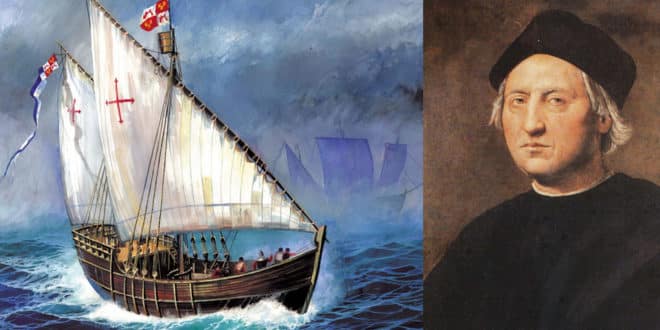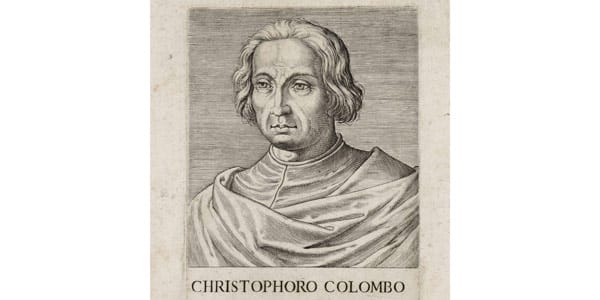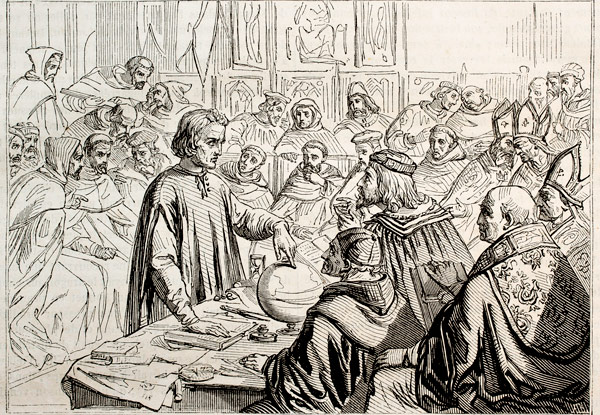Christopher Columbus (Cristoforo Colombo) is an outstanding figure, a legendary individual, a famous navigator, explorer, admiral, cartographer, and the discoverer of a new continent. He not only changed the world map but also altered the course of history itself. If you are only superficially familiar with this name, then our article is for you.
The story of the legendary Christopher Columbus will teach you that success is attainable through extraordinary patience and perseverance. When it seems that your strength is waning and the desire to give up is strong, the life path of this great explorer of new lands becomes a breath of fresh air, inspiring you to keep moving forward. His example of overcoming difficulties successfully serves as motivation for achievements and triumphs in our own lives.
And here is another crucial life lesson to be learned from Christopher Columbus’s biography: sometimes, not getting what you desire is actually a stroke of luck. A string of failures can sometimes be the launching pad for greatness, and the greatest mistake can lead to the greatest discovery.
Page Contents
Frequently Asked Questions about Columbus
So, let’s embark on the waves of the challenging yet glorious life journey of the legendary Christopher Columbus. But first, let’s answer the most popular questions about him:
Where was Christopher Columbus born?
What was Columbus’ nationality?
What did Christopher Columbus discover and when?
From where did Christopher Columbus set sail for America?
Who named America?
Interesting Facts about Christopher Columbus
- Due to the uncertainty of how long the first expedition would last and the unknown dangers that awaited the crew on this uncharted journey, few people willingly agreed to accompany Columbus. Therefore, the crew of the ships had to be forcibly recruited from prisoners serving serious sentences. In other words, Columbus was mainly accompanied by convicts on his first expedition.
- Even during his legendary voyages, Christopher Columbus always remembered that he was first and foremost an ordinary sailor. The voyages often prolonged, resulting in a shortage of provisions and fresh water on board. Columbus set himself a ration of a common sailor and, like everyone else, received one cup of fresh water per day. This earned him the respect of the crew, and as a result, there was no mutiny on the ship.
- Since the duration of the first expedition was unknown, Columbus had to hide the actual distance traveled from the crew. He significantly underestimated the numbers to avoid causing panic. The thing is, sailors at that time were accustomed to coastal navigation, and such vast distances were unfamiliar to them.
- The sailors on Columbus’s first expedition were cramped in unbelievable conditions. They had no more than 1 square meter of space per person. It was particularly challenging to get quality rest. They slept wherever they could: in the hold with the animals, on crates, on the deck, using their own often damp clothing as bedding, as there was nowhere to dry it. Only a few sleeping spots were available in the so-called “VIP cabins” for the captain and nobles. Hammocks and hanging bunks were introduced later, inspired by South American indigenous peoples. They only relieved themselves overboard. There was no means to wash up since fresh water was valued like gold. And let’s not forget about the constant rocking of the ship. All in all, it’s difficult to imagine the hardships of a sea expedition, especially considering our modern comfort expectations.
- The sailors who embarked on the first expedition with Columbus were so eager to see land after many days at sea that they mistook anything they encountered for it—be it whales, seaweed on the water’s surface, or a flock of albatrosses. Fortunately, after 70 days, their desperation was rewarded with the sight of actual land.
- During one of his expeditions, a portion of Columbus’s crew fell ill with scurvy. They had no means to treat the disease, so the sailors asked to be landed on any island where they could peacefully die. Columbus granted their request and disembarked them on an island near Venezuela. Several months later, Columbus’s ships passed by the same island with a stopover. To everyone’s surprise, they encountered their comrades alive and well! Thanks to the vitamins from the vegetables and fruits that grew on the island, they had recovered from scurvy. The island was named Curaçao, which means “recovery” in Portuguese. Moreover, the sailors had already married local girls and had no intention of returning home. It’s not surprising, who would want to go back to prison? Mass desertions began, and there was no one left to sail the ships back. It is said that Columbus had to use force.
- Christopher Columbus had excellent knowledge of astronomy, which once saved his own life and the lives of his crew. On the island of Jamaica, where Columbus and his team landed, they were surrounded by hostile indigenous people who intended to kill them. Columbus, aware of an upcoming solar eclipse, declared himself the controller of the sun and warned that if any harm came to his crew, he would extinguish the sun forever. When the eclipse occurred, the frightened indigenous people begged him to restore the sun to its place and released the prisoners.
- While it is well-known that Columbus brought various items from America to Europe, not many are aware that he also brought certain things from Europe to America. Primarily, he introduced grapes, cows, and horses to the New World.
- Surprisingly, Columbus cannot be considered the actual discoverer of America, as European presence on American soil dates back to the Middle Ages with the arrival of Icelandic Vikings. However, knowledge of these expeditions did not spread beyond Scandinavia. Columbus made America open and accessible to all, thus initiating European colonization of the continent.
- In his time, Columbus was just one of many explorers venturing to distant lands. However, his achievements were recognized and appreciated centuries later.
Biography of Columbus
It must be said that over the course of several hundred years, starting from the 15th century, the figure of Christopher Columbus has become surrounded by numerous legends, rumors, and speculations. This often happens. There are many gaps in his biography. However, one thing remains unchanged – he did indeed discover and make America known to Europeans (though only the South and Central America with their archipelagos and islands, as Columbus’ foot did not touch North America).
Christopher Columbus was born on October 31, 1451, into a modest family. His desire to escape poverty, as well as his erudition, inquisitive mind, and faith in God, determined the course of his life. And he was drawn to the sea…
To this day, remnants of the house where Christopher spent his childhood have survived.
They can be seen in Genoa at Via di Porta Soprana, 16121 Genova.
In Genoa, not far from the main train station, there is also a monument with the inscription “A CRISTOFORO COLOMBO LA PATRIA” (To Christopher Columbus, the Fatherland).
Christopher Columbus studied at the University of Pavia (Università degli Studi di Pavia), located in Lombardy, where he received an excellent education. He married the daughter of a sailor, and they had a son named Diego. Later, Columbus had another son with another woman, either a common-law wife or a new official wife (the exact details are unknown). Columbus loved his sons dearly, pampered them, lavished gifts upon them whenever possible, and made no distinction between them.
Where was Columbus initially planning to go
So, starting from 1470 and largely thanks to his father-in-law, Christopher Columbus began participating in maritime expeditions and first began contemplating his project of a sea voyage to India. Why India specifically? It was a promised land, full of gold, precious stones, valuable materials, unique spices, and herbs. Simply paradise on Earth! Discovering a sea route to India would make an ordinary sailor famous and immensely wealthy.
It is believed that it was the Italian astronomer and geographer Paolo Toscanelli, whom Columbus had met during his university studies, who informed him that the maritime route to India would be much shorter if one sailed westward. However, Columbus himself made calculations and studied the works of other explorers and geographers.
However, Columbus had to endure numerous hardships before embarking on his long-awaited expedition! Judge for yourself.
Expedition Preparation
In 1476, Columbus moved to Portugal, from where he traveled extensively to different countries’ shores. A few years later, he first approached the government of his hometown, Genoa, with a proposal to organize an expedition to discover a shorter sea route to India via the west. However, there was no response. Several years later, he addressed the same proposal to the King of Portugal. The monarch referred his project to the experts at the Lisbon Academy of Astronomy and Mathematics. The experts considered Columbus’s calculations “fantastic,” and the king rejected Columbus’s request.
In 1485, the indomitable sailor relocated to Spain. In an incredible turn of events, he established contact with the King of Spain through new chance acquaintances. The project intrigued the king, but the country was engaged in a protracted war with Granada, making the beginning of a costly new venture seemingly impossible. However, Columbus didn’t give up and turned to the King of England, who initially appeared somewhat supportive of organizing the expedition, but it didn’t progress beyond mere words…
Meanwhile, the war between Spain and Granada came to an end, and a faint glimmer of hope appeared for the navigator. However, the ambitious Columbus presented such demands in the event of a successful expedition that the Spanish king hastened to retreat from making a decision. Of course, not every king is willing, even in advance, to acknowledge a sailor as the “Admiral of the World Ocean” and appoint him vice-king of all newly discovered lands.
But then Providence intervened. During negotiations with the Queen of Spain, Christopher Columbus hinted at the possibility of liberating the Christian holy relics in Palestine, lost during the Crusades, in the event of a successful expedition. At this point, the queen could not stay aside and give a chance to other countries. She pledged her precious possessions. Approval for the expedition was granted, and Columbus and his heirs were granted the title of “Don” and all other demands of the navigator, in case of expedition success, were agreed upon.
However, part of the financing remained in question, and Columbus had to personally seek and attract wealthy patrons, even covering one-eighth of all expenses himself.
The Discovery of America. The Route
In total, Christopher Columbus embarked on 4 exploratory expeditions to America:
1492-1493: The First Expedition
Objective: To find the shortest route to India. The smallest expedition. Three ships (“Santa Maria,” “Pinta,” and “Niña”) and a crew of 90 people. As a result of the first expedition, America was discovered.
On October 12, 1492, land was sighted from the deck of the “Pinta.” The Spaniards reached the islands of the Bahamas archipelago. Columbus landed on the shore, raised the flag of Castile, and, drawing up a notarial act, formally took possession of the island. He named the island San Salvador (Holy Savior), which is now the modern island of Samana. Columbus was convinced that he had reached the shores of India. He explored other Bahamian islands, discovered territories along the northeast coast of Cuba, and the island of Haiti.
Soon, the ship Santa Maria collided with a reef and sank. The crew of the flagship managed to survive, but the expedition had to turn towards the shores of Spain with the remaining two ships. The navigator brought back trophies: natives, gold, feathers of exotic birds, and exotic fruits. The Spanish monarchs welcomed him with open arms and approved a second expedition.
Replicas of Christopher Columbus’ ships for his first voyage to America, the Niña, Pinta, and Santa Maria, can now be seen at the Caravel Wharf (Muelle de las Carabelas), a museum in Palos de la Frontera, in the province of Huelva, Andalusia, Spain.
1493-1496: Second Expedition
Christopher Columbus was already serving as Admiral. This was the most extensive and expensive expedition, consisting of 17 ships and a crew of 2,500 people. During the expedition, the following islands were discovered: Guadeloupe, the Dominican Republic, the Lesser Antilles, Puerto Rico, Jamaica, and Huventud. The southern coasts of Cuba and Haiti were also explored. Additionally, a military campaign was conducted in Haiti in search of gold.
1498-1500: Third Expedition
Экспедиция насчитывала 6 кораблей. Мореплаватель вышел к берегам Южной Америки, обследовав Тринидад, залив и полуостров Пария, реку Ориноко.
The expedition consisted of six ships. Columbus reached the shores of South America, exploring Trinidad, the Gulf of Paria, and the Orinoco River.
When the expedition arrived at the shores of Haiti, Columbus was arrested and sent back to Castile. The reason for this was unexpected but predictable. The new colony had become a burden for the Spanish monarchs. It became clear that the land Columbus had discovered would not bring the fabulous wealth expected, and that it was likely not India. Columbus was accused of deception and misappropriation of royal revenues. He, along with his brothers who participated in the expedition, was sent to Spain in chains. Although the monarchs released Columbus shortly after, he was demoted, humiliated, and insulted. However, this did not break the spirit of the great explorer, and Columbus began preparing for another voyage.
1502-1504: Fourth and Final Expedition of Columbus
During this expedition, new territories came under the Spanish crown, including the island of Martinique, the Gulf of Honduras, and the extended coast of South America, washed by the Caribbean Sea. Unfortunately, in 1503, the ships suffered a wreck near Jamaica. Columbus requested assistance from the island of Santo Domingo, which arrived only a year later.
The admiral’s health was severely affected by the exhausting voyages, viruses, and unfamiliar diseases he contracted on the islands. He was also greatly disappointed that the route to India had not been found. After the fourth expedition, Columbus never fully recovered his health and passed away shortly thereafter.
Conclusion
On the one hand, Christopher Columbus suffered a fiasco: he never found a sea route to India, he was mistaken about his discovery, engaged in endless and exhausting disputes with monarchs, lost titles and money, and was physically and morally exhausted. Even the new continent was named after Amerigo Vespucci, who was not its actual discoverer. Christopher Columbus died a poor, sick, disillusioned man. It was his personal tragedy.
But let’s look at all of this from a different, correct perspective:
Christopher Columbus spent his entire life engaged in his beloved profession – seafaring. A simple sailor gained recognition from kings and queens, and although not immediately, convinced them of the success of his endeavor.
The discovery of a new continent is much more important and monumental than finding a sea route to India, even if the admiral himself did not fully realize it.
Christopher Columbus made a tremendous contribution to the development of Europe. After Columbus’s discovery, the world entered the Age of Discovery. Prior to that, Europe was a relatively poor state engaged in wars over limited resources and lacked global dominance. Thanks to the influx of gold and silver, as well as the importation of fertile plant crops from America, Europe’s industry and science began to flourish. The population grew, and the quality of life improved.
And although Columbus remained just one of the sailors venturing into distant lands in his era, his merits were recognized much later, after centuries. And in that lies Christopher Columbus’s tremendous success and fortune. He dedicated his life to serving humanity, for the sake of peace.
I would like to thank Victoria Mukhurova for her assistance in preparing the material.
 Italy for me From Italy with love
Italy for me From Italy with love






